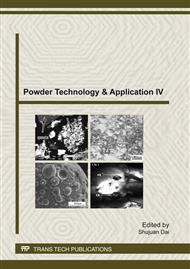[1]
X. He:Journal of China Coal Society, Vol. 33 (2008), p.63.
Google Scholar
[2]
X. He, in: Waste water Processing and mine Drainage Resources (Coal Industry Press, China 2002).
Google Scholar
[3]
M.M. Matlock, B.S. Howerton, D.A. Atwood: Water Res, Vol.36 (2002), p.4757.
Google Scholar
[4]
M.M.G. Chartrand, N.J. Bunce: Appl. Electrochem, Vol.33 (2003), p.259.
Google Scholar
[5]
H.R. Diz, J.T. Novak: Eng, Vol.124 (1998), p.701.
Google Scholar
[6]
I. Doya, J. Duchesne: Appl. Geochem, Vol.18 (2003), p.1197.
Google Scholar
[7]
K. Dorfner, Ion Exchangers, Walters de Gruyter, Berlin, 1991.
Google Scholar
[8]
J.W. Wang, D. Bejan, N. Bunce: Environ. Sci. Technol, Vol.37 (2003), p.4500
Google Scholar
[9]
D.R. Jenke, F.E. Diebold: Water Res, Vol.17 (1983), p.1585.
Google Scholar
[10]
S. Santos, R. Machado, M.J.N. Correia: Miner. Eng, Vol. 17 (2004), p.225.
Google Scholar
[11]
J.G. Webster, P.J. Swedlund, K.S. Webster: Environ. Sci. Technol, Vol.32 (1998), p.1361.
Google Scholar
[12]
US EPA report, 14010 DYG8/71 Acid Mine waste treatment using reverse osmosis, Washington, DC, 1971.
Google Scholar
[13]
B. Gazea, K. Adam, A. Kontopoulos: Miner. Eng.Vol. 9(1996), p.23.
Google Scholar
[14]
D.B. Johnson, K.B. Hallberg: Sci. Total Environ, Vol. 338 (2005), p.3.
Google Scholar
[15]
U. Wingenfelder, C.Hansen, G. Furrer, R. Schulin: Environ. Sci. Technol,Vol.39(2005),p.4006.
Google Scholar
[16]
N. Moreno, X. Querol, C.Ayora C.F. Pereira, M. Environ. Sci. Technol, Vol.35 (2001), p.3526.
Google Scholar
[17]
D.C. Luo, P.G.Yi, A.G. Chen: Technology of Water Treatment, Vol. 29(2003), p.338.
Google Scholar
[18]
S.J. Fan, C.M. Wang, X.X. Feng: Non-Metallic Mines, Vol. 29(2006), p.56.
Google Scholar
[19]
Y.L. Wang, L.G.Hu, Y.Z.Ma: Fisheries Science & Technology, Vol. 1(2006), p.20
Google Scholar
[20]
Zorpas A A, Constantindes T, V1yssiJes A G, eta1: Technology, Vol. 72(2000), p.113.
Google Scholar
[21]
Y.L. Guo, Q.Wu, Y.X. Wang, eta1: Chongqing Environmental Science, Vol. 9(2003), p.26.
Google Scholar
[22]
B.Y.Gu, Y.S. Shang, J.Wu, etal: Ion Exchange and Adsorption, Vol. 24(2008), p.154.
Google Scholar
[23]
Y.F. Pan, etal: China Mining Magazine, Vol. 17(2008), p.87.
Google Scholar
[24]
C.A. R´ ıos et al: Journal of Hazardous Materials, Vol. 156 (2008), p.23.
Google Scholar


